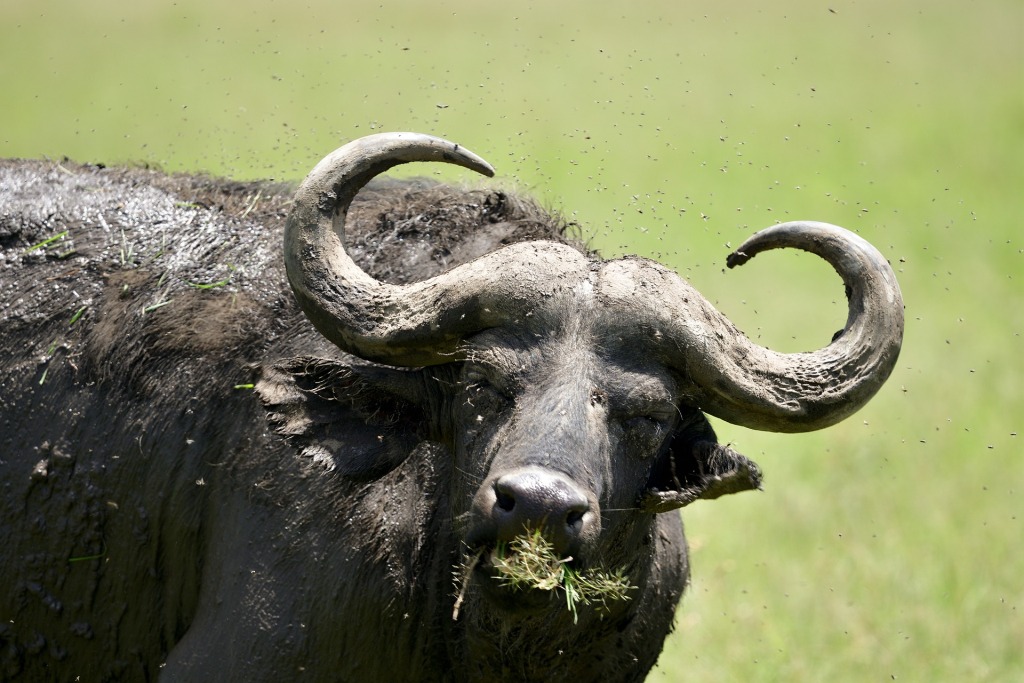This is one of the best safaris to see Kenya’s wildlife. Travel through the most interesting national parks that host incredible wildlife. These include Samburu National Park, Aberdares National Park, Lake Nakuru National Park, Masai Mara National Park, Tsavo East, Tsavo West National Park, Amboseli National Park and Lamu.

Trip Itinerary
Days 1 & 2: Samburu National Reserve
From Nairobi, safaris head north to the Samburu National Reserve for a couple of nights at one of the lodges on the banks of the Ewaso Ng’iro River, where most of the game is concentrated. Animals include giraffes, elephants, hippos, crocodiles, buffalos, lions, leopards, cheetahs, and hyenas, and more than 365 types of birds. Look out for species here not seen farther south, such as Grevy’s zebra, Somali ostrich, and gerenuk, an unusual antelope that can reach up the trees on its hind legs.
Day 3: Aberdares National Park
Heading south, the option is to spend a night in one of the two unusual lodges in the Aberdares National Park: Treetops, where Princess Elizabeth stayed in 1952 on the night her father died and she became queen, or the Ark built in the shape of Noah’s Ark. At night, stay up to watch the game activities over the floodlit waterholes. This park is unusual in that it lies above 21,000m (68,880 ft.) and so has a more alpine feel, with mountains, streams, valleys, and moorland.
Day 4: Lake Nakuru National Park
After another morning game drive, your safari will head to Nakuru. Situated just a stone’s throw from the town, the attractive Lake Nakuru National Park surrounds the lake of the same name, which is a haven for the pink lesser flamingo as well as hippo. Other species include various antelope, giraffe, zebra, lion, rhino, and leopard (which can actually be spotted during daylight hours in the arms of the giant yellow acacia trees near the entrance). Enjoy the great views from the park’s rocky escarpments and ridges. Accommodation can be found at several lodges and campsites.
Days 5 & 6: Masai Mara Game Reserve
You will spend at least 2 nights in the Masai Mara Game Reserve, Kenya’s most famous park with an extraordinary density of animals, including the Big Five. In July and August, it’s also the scene of the Migration, when hundreds of thousands of wildebeest, plus smaller numbers of zebra and antelope, arrive in search of fresh grazing from Tanzania’s Serengeti National park to the south. The predators follow the herds, so this is the best time to witness plenty of animal action, especially if you get the opportunity to see the wildebeest cross the Mara River, where they have to dodge crocodiles, too. There are dozens of places to stay, from hotel-style lodges to tented camps.
Day 7: Nairobi
After an early morning game drive, you’ll head back to Nairobi, a 6-hour drive away.
Day 8 & 9: Nairobi
Spend at least half a day on a game drive in the Nairobi National Park, which, with the city as a backdrop, is home to all of the Big Five except elephants, but these can be seen on the morning excursion to the David Sheldrick Animal Orphanage adjoining the park. Here you can watch baby elephants tearing around; kids will love it. They’ll also enjoy feeding the giraffes at the Langata Giraffe Centre.The nearby Karen Blixen Museum looks at Kenya’s colonial past. End one evening at the Carnivore restaurant, where meat is roasted on Maasai spears.
Days 10 & 11: Tsavo East and West National Parks
One of Kenya’s oldest and largest national parks, this is split by the Nairobi-Mombasa road and railway. It’s administered as Tsavo East and Tsavo West; its southern plains meet those in Tanzania’s Serengeti National Park. The diverse range of habitats — mountains, river, forest, lakes, and grassland — are home to rhinos, lions, leopards, crocodiles, waterbucks, kudus, hartebeests, and zebras, as well as some of the largest herds of elephants in Kenya. There are plenty of isolated lodges and campsites to choose from.
Days 12 & 13: Amboseli National Park
Amboseli National Park is famous for its wonderful image of elephants on the grassy plains, with Kilimanjaro’s snow-covered peaks in the background. Plentiful game to look for includes zebras, wildebeests, giraffes, impalas, lions, and leopards, and bird-watchers may spot pelicans, African fish eagles, and pygmy falcons. As one of Kenya’s most popular parks, there’s a full range of accommodations.
Day 14: Nairobi
After a morning game drive, return to Nairobi.
Days 15 & 16: Northern Beaches
After breakfast, transfer to Mombasa, there’s a string of popular vacation resorts on the north side of Malindi, from where the road continues through coastal bush to the islands of the Lamu Archipelago. Each resort has access to the beach, and the Indian Ocean marine life of coral, fish, sea turtles, and dolphins can be seen by snorkeling and diving, or more sedately from a dhow or glass-bottom boat. Directly north of Mombasa, the palm-fringed Nyali and Bamburi beaches fall within the small Mombasa Marine Park, while beyond, the bustling town of Mtwapa is flanked by the sheltered Shanzu Beach. Farther up the coast, Malindi has another set of idyllic tropical beaches, though seaweed can be a problem here. The Malindi Marine Park again offers reefs full of tropical fish, and you can dive and snorkel around Casuarina Point.
Days 17 & 18: Lamu
From Malindi, the road continues through coastal bush to the islands of the Lamu Archipelago, located in the extreme north of Kenya. Lamu has a lovely 13km (8-mile) isolated beach at Shela, with perfect sand and no reef, which means substantial waves. Lamu town, with its long waterfront lined with white-sailed dhows and its intriguing network of alleyways, warrants a day’s exploration to enjoy its time-warped traditional Swahili atmosphere. A few luxurious and exclusive resorts lie hidden among the islands, or you can stay in a traditional Arabic house in Lamu or Shela. Also make time to sample local cuisine; little alcohol is available in the predominantly Islamic islands, but the coconut juice is legendary, as is the Swahili-style seafood.
Days 19-21: Southern Beaches
The beaches are backed by lush green coastal forest with prolific birdlife and a variety of wildlife, including baboons and black-and-white colobus monkeys. Tiwi Beach is the first tourist beach south of the ferry (across Mombasa Harbor) and has some large hotels popular with families and budget travelers; when the tide goes out, kids can explore the hundreds of exposed rock pools. Farther south, Diani Beach is one of the nicest on the coast, with bright blue water and a long expanse of white sand. There are several reefs offshore that can be explored by snorkeling from a dhow or glass-bottom boat, and the nearest ones can be waded out to at low tide. The sea here is an intense turquoise blue, and the park has a range of reefs and small islands where dolphins and turtles are regularly spotted. If you are staying at Diani Beach, day trips to the park are available that include dhow rides, snorkeling, and a seafood lunch on Wasini Island.

